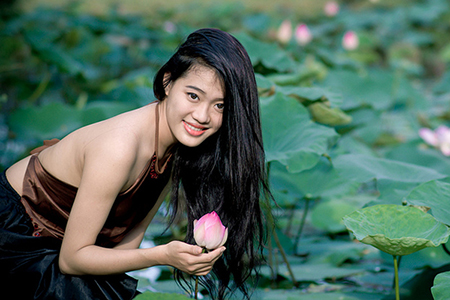A Vietnamese folk verse tells us:
Three young girls carry baskets of rice on their heads to the pagoda,
A Vietnamese folk verse tells us:
Three young girls carry baskets of rice on their heads to the pagoda,
But the girl wearing the beautiful yem bra charms the monk.
Another folk verse tells of a girl who nourishes the following hope:
If only the river could be as wide as the span of my hand
And my yem's ribbon, a bridge for you to come see me.
The wood carvings at some communal houses built during the seventeenth and eighteenth centuries show young female dancers wearing Vietnamese yem that vaguely show the outline of their surging, beautiful breasts. In a traditional cheo opera, Thi Mau likes to flirt with men. One day after returning from the village pagoda, she gives her servant a provocative "No:"

The spring wind has lifted my peach yem,
You saw the rice-cake cones beneath,
Why not come light the incense?
In the old days, when a boy fell in love with a girl and wanted her to consider his love, he would touch her hand. She communicated acceptance of his love by allowing him to touch her hand, and he then knew he had covered half the ground to conquer her. He had completely conquered her only when he could touch her yem ribbon.
The Vietnamese yem first appeared in ancient times, but the general shape it has today dates from the Ly Dynasty. Since 1802, the yem has been a square piece of cloth with two of the corners above the woman's breasts. The front of yem worn by aristocratic women had braided ribbons. Working women usually wore a round-collar yem. At that time, there was also a "split-collar yem" and an yem with the split plunging downwards and called a "swallow-winged yem."
By 1920, coquettish girls liked colourful yem with the split plunging near their breasts. Young girls liked light colours such as aqua, sky-blue, and rose, whereas middle-aged women wore darker colours. Working women wore light brown or dark brown yem. Women tied four long strips of cloth, two at each side tie the yem, together at the back of the neck and at the waist. They tied the strips firmly when working but loosely during times of leisure, and sometimes, very loosely.
The top comers of the yem had three stitched lines to make the collar more durable and more beautiful. Some women embroidered flowers at this spot. They decorated the ribbons in a colour that complemented the rest of the yem. Some women would sew a tiny bag of perfume onto the ribbons to turn the heads of their admirers. Girls sometimes attached betel quids for their lovers to their yem ribbons.
Women wore an unbuttoned white shirt over the yem. The white contrasted with the deep yellow or dark red of the yem. When outside the house, they wore skirts of floor-length black satin or coarse silk and an outer robe as well as belts that were yellow, rose, or green. They might attach to one side of the belt a silver chain with a lime-pot and a small knife to cut areca nuts. Most women wore sandals.

They parted their hair in the middle or the side and wrapped it in a turban made of black silk or black velvet, leaving a lock of hair hanging at one side of the face. Women who didn't wear a turban rolled their hair with a small comb. Girls attending festivals wore hats with a narrow rim to be more graceful. These accessories harmonized with the yem to make women seem graceful, sweet, and closer to Nature.
The yem remains in occasional use today at traditional festivals and performances, for foreign tourists and Vietnamese alike value its beauty.



